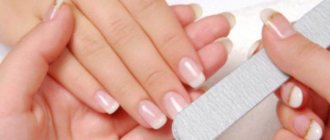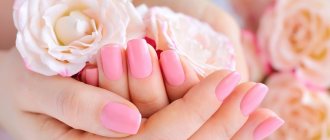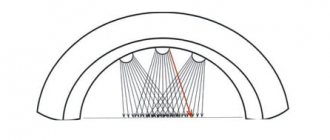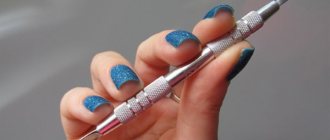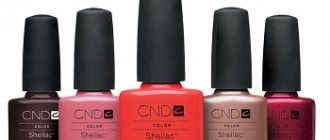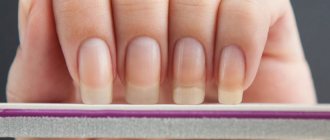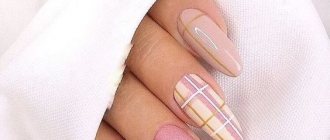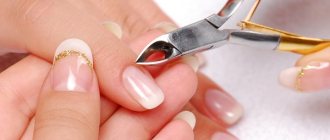The gel polish lamp can be ultraviolet, light emitting diode (LED), hybrid and CCFL. Each type of equipment differs in power, type of luminous flux, and the presence of additional functions. The drying time of the coating depends on what exactly is chosen for the job, and it can range from 30 seconds to 3 minutes.
The most popular lamps are considered to be hybrid ones, but they are expensive – some models will cost 20 thousand rubles. For home use, it is better to choose ultraviolet or LED devices - their cost is several times lower and does not exceed 5 thousand rubles. There are also very cheap options on sale - mini-lamps for individual use, their cost starts from 300 rubles.
Why do you need a lamp for gel polish?
A lamp for gel polish is needed so that the material used hardens and becomes a full-fledged, reliable coating. If acrylic and gel for nail extensions of the first generation are able to harden only under ultraviolet rays, then modern gel polishes are made with such a composition that polymerization proceeds well in LED lamps.
Depending on what type of equipment is chosen, you can clearly calculate the time required to fix/harden each layer of gel polish.
We recommend reading the article about the difference between gel polish and shellac. From it you will learn what is the difference between gel polish and shellac, what is better and what is more harmful, and also how to extend the wearing period. And here is more information about how to remove shellac at home.
Gel lamp
If you are deciding which dryer for nail extensions is better, then preference should be given only to devices with a power of at least 36 watts. They are the most versatile, both gel and shellac dry under them, and you can also perform extensions. UV lamps of lower power are not able to cause the polymerization process in the gel.
For professionals, a nail dryer with airflow into the working chamber is more suitable for nails. With a large flow of clients and continuous operation, the chamber heats up significantly. The procedure for applying shellac and extensions involves more than one use of the lamp, so the high temperature in it can cause discomfort to the client.
https://youtu.be/H7yGSzKnQr8
[yandex3] [google3]
How does a gel polish drying lamp work?
Inside each lamp for drying gel polish there are light bulbs that emit light waves of a certain length. Most often, the range of parameters ranges from 280-400 nm, and this allows the same type of equipment to be used for the polymerization of any material - gel polish, acrylic, shellac.
The lamps are turned on “manually” using a mechanical toggle switch/switch, but you can control the operating mode of the device in different ways:
- using a timer - the master automatically sets the time for exposure to light on nails;
- using a conventional switch - the specialist himself stops the light exposure;
- combined - the lamp has both a timer and a manual switch.
Lamp power: what you should pay attention to
One of the main criteria for choosing a UV lamp for full operation is the power of the purchased model. This indicator depends on the number of ultraviolet replacement lamps in the device body, as well as the presence of reflective internal panels that make the light more uniform. The quality and polymerization time of the coating depends on how powerful the UV lamp for drying gel polish is on your or your master’s table.
- Mini models of UV lamps can have a power of 9 W and 18 W (for 1 and two replaceable lamps, respectively). This option is ideal for amateurs who are mastering the art of nail art for themselves. watt
- A 36-watt ultraviolet lamp (four replaceable lamps) provides full-fledged work with the material and is often used with a fairly active flow of clients in small nail salons or at the home of a practicing master.
- More powerful 54W UV equipment (six lamps in the housing) ensures the fastest polymerization of multi-layer gel polish designs or dense artificial nails modeled using gel.
How much does a gel polish lamp cost?
How much a gel polish lamp will cost depends on the quality level of the equipment, the name of the device manufacturer, and the type of lamp, but general price data is as follows:
- Professional devices are the most expensive, and among them CCFL and LED lamps are particularly expensive - you will have to pay between 20-50 thousand rubles. This category of luxury goods includes hybrid lamps, the cost of which starts from 40 thousand rubles.
The cheapest, but no less effective, are devices that work with ultraviolet light - professional products will cost an average of 10 thousand rubles.
- Equipment for drying gel polish made in China is in the average price range; their cost ranges from 3-5 thousand rubles per lamp with ultraviolet light, and more modern models (LED) can be purchased for 5-7 thousand rubles. Lamps from domestic manufacturers also fall into this category.
The cost of equipment is not an indicator of its quality, because often these lamps are distinguished by their long service life, efficiency, maintainability, and ease of use.
- The cheapest lamps are from virtually unknown manufacturers; they can be purchased for 600 rubles, and the maximum cost of such products is only 2 thousand rubles. This equipment is distinguished by ease of use, limited capabilities, and short service life.
It is not correct to choose a lamp for drying gel polish based only on its cost; you need to take into account other criteria, the degree of importance of which is determined individually.
How to choose a lamp for drying gel polish, how much do they cost?
You can choose a lamp for drying gel polish and find out how much they cost, taking into account the types of such equipment.
| Lamp type | Brief description, price | Photo |
| Ultraviolet | They can be with touch and mechanical control, the power ranges from 9-54 kW, suitable for the polymerization of almost all materials. The price is within 3 thousand rubles. | |
| LED lamps | They are distinguished by a high drying speed of gel polish and a long service life without replacing light elements. The price ranges from 5-8 thousand rubles. | |
| CCFL devices (cold cathode) | They are distinguished by high power, have a timer and manual control of modes, and have a wide spectrum of radiation. The cost is around 7 thousand rubles on average. | |
| Hybrid | They combine cold cathodes and LED elements, dry any type of gel polish equally quickly and efficiently, and are distinguished by high power. The price of equipment starts from 20 thousand rubles. |
Ultraviolet (UV)
UV lamps are the simplest and cheapest option among equipment for drying gel polish. Initially they were of a simple design, but subsequent models were produced with fluorescent light bulbs. Main characteristics of ultraviolet lamps for gel polish:
- power – ranges from 9-54 kW;
- control method - touch or manual;
- material drying time – 30 seconds – 1.5 minutes;
- capacity is large, you can dry two hands at the same time;
- what it is used for - for almost all types of gel polishes.
The pronounced advantages of ultraviolet lamps include relatively low cost, varied design of the device and a wide range of uses. But there is also a drawback to such equipment - the closer the day for mandatory lamp replacement is, the worse the drying of the coating goes; it can curl and bubble.
This is considered the most budget option, but a little outdated. Gel polish takes a long time to dry in such a device, has impressive dimensions and periodically requires replacement of light bulbs. The disadvantages also include the negative impact of ultraviolet radiation on the skin and nail plates - they dry out greatly. The problem is solved by using moisturizing cosmetics such as creams and cuticle oils.
LED lamps
These are LED devices that “entered” the accessory market relatively recently. They have the following quality characteristics:
- the most popular LED lamp power is 6 W;
- nail drying time – maximum 30 seconds;
- may have built-in LED lamps on the top/bottom and on the sides;
- equipped with an automatic shutdown timer;
- Suitable for working with all types of gel polish.
Such lamps operate on LED elements, and this automatically reduces energy costs. Even if 1-2 light bulbs burn out in the device, the drying efficiency will not decrease.
The only drawback of LED lamps is their cost: it is several orders of magnitude higher than ultraviolet equipment, but relatively acceptable for purchasing a device even for home use.
Gas light with cold light
These lamps are equipped with cold cathodes and have a high price, but it is fully justified by their high quality characteristics:
- extremely low power consumption;
- rays of light do not have a negative effect on the eyes, skin or nail plates;
- drying is carried out quickly, literally in a few seconds for each layer;
- long service life of the equipment.
Gas-light lamps for drying gel polish with cold light have recently begun to be used by nail industry professionals, so you should not purchase them for home use. The price of lamps is too high, making it advisable to purchase cheaper options.
Hybrid
Hybrid lamps combine two sources of light waves - LED and CCFL, which makes them most effective specifically for drying gel polish. Their quality characteristics:
- the average power of hybrid lamps is 48 watts, professional models reach 66 watts;
- the device is equipped with a timer; you can set the lamps to automatically turn off after the time has elapsed for the next layer to dry;
- the chamber is designed for drying one hand;
- “works” equally effectively with any type of decorative coating;
- long service life.
Since hybrid lamps can be used for drying any types of gel polish (including acrylic, bio), it is advisable to purchase them for those who “handle” many clients and have to work with different materials.
Mini lamp
The main difference between a mini-lamp and a regular device is its size, which is as compact as possible. They allow you to dry only a few fingers at a time; most often they are used to dry just 1 finger.
Such devices have:
- open body design;
- weak focusing of ultraviolet light on the nail plate;
- negative effect on nails and the skin around them (very dry);
- low power.
Mini lamps for drying gel polish can be of different types of radiation, but experts recommend choosing LED devices. Disadvantages of such compact equipment:
- the polymerization time for all nails is long, because the procedure has to be done with each nail separately;
- the design does not provide additional functions such as a fan or reflector;
- low radiation power;
- there is no tray.
But such equipment also has undeniable “advantages” - they are powered not only from the mains, but also from a laptop, and are portable (they can easily fit even in a handbag).
The cost of devices of this type is low and starts from 300 rubles. The lamp body is made of cheap plastic, so when purchasing you need to pay attention to the absence of chips and “sagging”.
Precautionary measures
Despite the scientists' findings, members of skin cancer organizations still insist on the negative effects of manicure lamps. So how can you protect your hands from damage and protect yourself from even the slightest influence of ultraviolet radiation on the skin?
Scientists recommend that lovers of gel polish manicures apply sunscreen to their hands or wear protective gloves to reduce the risks of developing skin cancer and premature aging.
It is worth noting that gloves also have their drawbacks. The SPF of white cotton gloves will only be around 4, so for best protection you will need dark, opaque gloves.
Sunscreen is a more practical option, but even if you apply it on the way to the salon, it will most likely wash off if the manicurist uses soap, water, scrubs, and lotion during the manicure process. If you really want to protect your hands during a manicure, you will have to sacrifice these joys.
